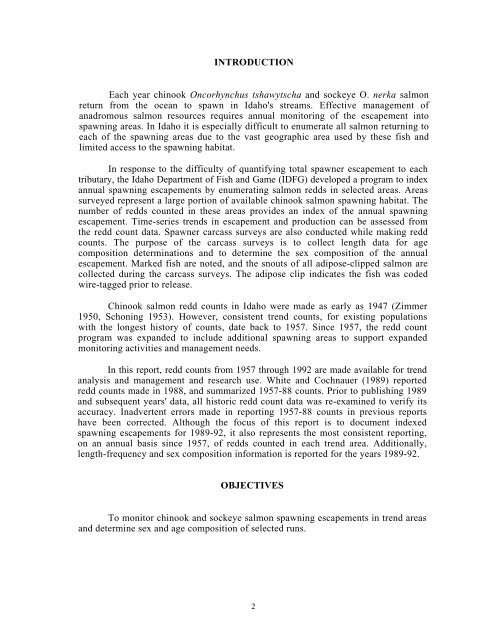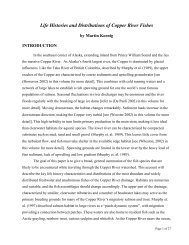Salmon Spawning Ground Surveys, 1989-92 Project F-73-R-15
Salmon Spawning Ground Surveys, 1989-92 Project F-73-R-15
Salmon Spawning Ground Surveys, 1989-92 Project F-73-R-15
Create successful ePaper yourself
Turn your PDF publications into a flip-book with our unique Google optimized e-Paper software.
INTRODUCTION<br />
Each year chinook Oncorhynchus tshawytscha and sockeye O. nerka salmon<br />
return from the ocean to spawn in Idaho's streams. Effective management of<br />
anadromous salmon resources requires annual monitoring of the escapement into<br />
spawning areas. In Idaho it is especially difficult to enumerate all salmon returning to<br />
each of the spawning areas due to the vast geographic area used by these fish and<br />
limited access to the spawning habitat.<br />
In response to the difficulty of quantifying total spawner escapement to each<br />
tributary, the Idaho Department of Fish and Game (IDFG) developed a program to index<br />
annual spawning escapements by enumerating salmon redds in selected areas. Areas<br />
surveyed represent a large portion of available chinook salmon spawning habitat. The<br />
number of redds counted in these areas provides an index of the annual spawning<br />
escapement. Time-series trends in escapement and production can be assessed from<br />
the redd count data. Spawner carcass surveys are also conducted while making redd<br />
counts. The purpose of the carcass surveys is to collect length data for age<br />
composition determinations and to determine the sex composition of the annual<br />
escapement. Marked fish are noted, and the snouts of all adipose-clipped salmon are<br />
collected during the carcass surveys. The adipose clip indicates the fish was coded<br />
wire-tagged prior to release.<br />
Chinook salmon redd counts in Idaho were made as early as 1947 (Zimmer<br />
1950, Schoning 1953). However, consistent trend counts, for existing populations<br />
with the longest history of counts, date back to 1957. Since 1957, the redd count<br />
program was expanded to include additional spawning areas to support expanded<br />
monitoring activities and management needs.<br />
In this report, redd counts from 1957 through 19<strong>92</strong> are made available for trend<br />
analysis and management and research use. White and Cochnauer (<strong>1989</strong>) reported<br />
redd counts made in 1988, and summarized 1957-88 counts. Prior to publishing <strong>1989</strong><br />
and subsequent years' data, all historic redd count data was re-examined to verify its<br />
accuracy. Inadvertent errors made in reporting 1957-88 counts in previous reports<br />
have been corrected. Although the focus of this report is to document indexed<br />
spawning escapements for <strong>1989</strong>-<strong>92</strong>, it also represents the most consistent reporting,<br />
on an annual basis since 1957, of redds counted in each trend area. Additionally,<br />
length-frequency and sex composition information is reported for the years <strong>1989</strong>-<strong>92</strong>.<br />
OBJECTIVES<br />
To monitor chinook and sockeye salmon spawning escapements in trend areas<br />
and determine sex and age composition of selected runs.<br />
2
















